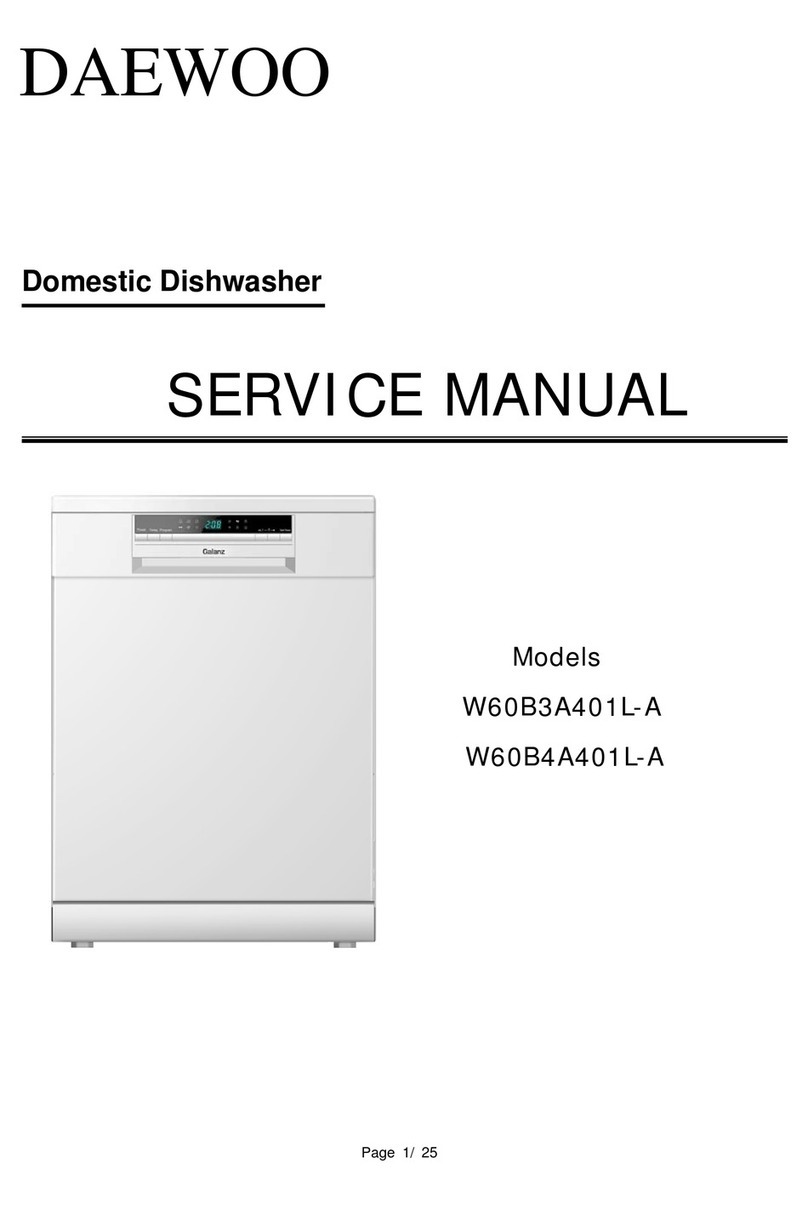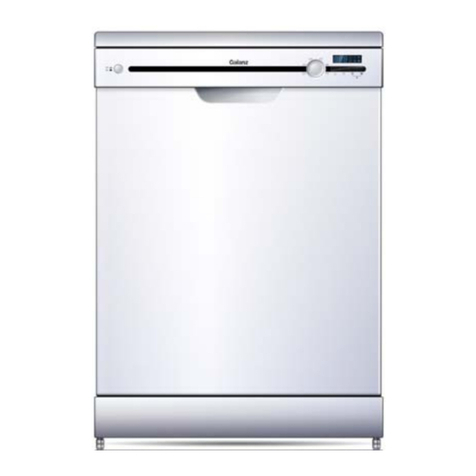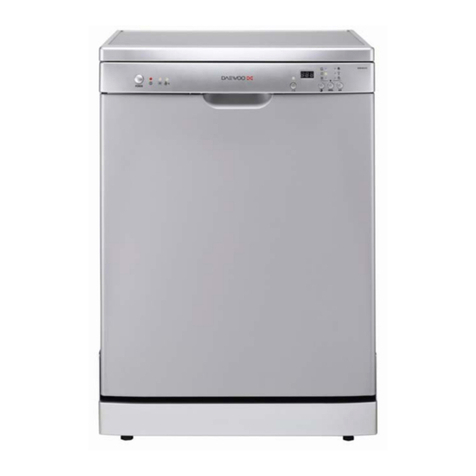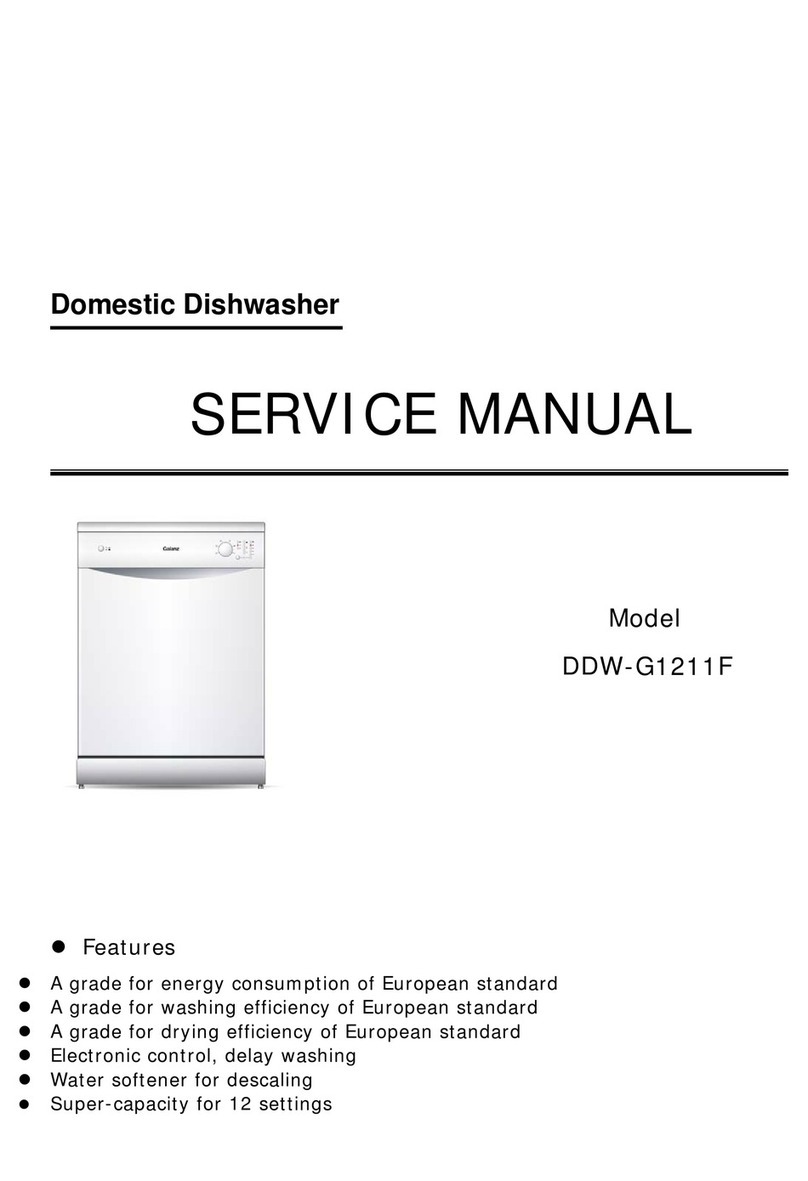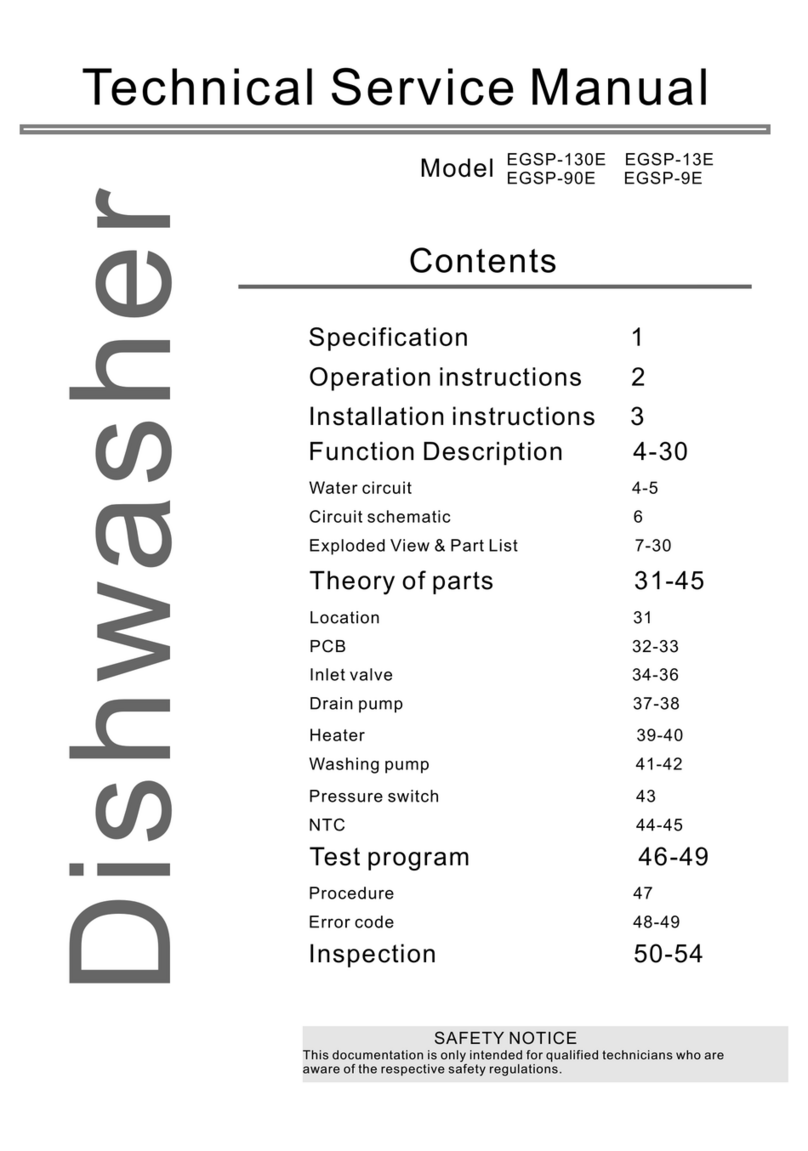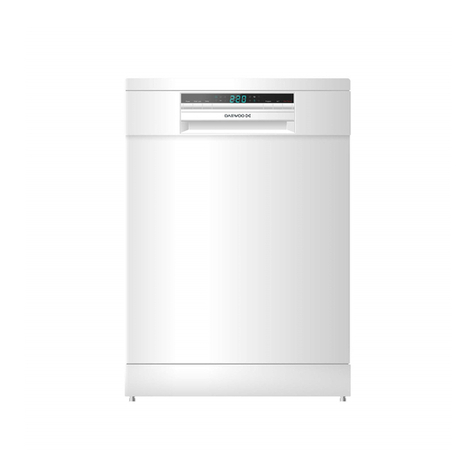Daewoo DDWMJ1411W User manual

Operang Instrucons
Daewoo Model NO. DDWMJ1411W
Before using product, please read this manual carefully and keep it for the future reference.
Customer Helpline Number : 03330 144477
For more informaon, Visit DAEWOO ELECTRONICS Website
www.daewooelectronics.co.uk
14 plate sengs

Contents
This appliance is intended for private domesc use only.
1) Safety Instrucons
2) Quick operaon guide
3) Operaon Instrucon
•Control Panel .
•Dishwasher Features
4) Before using the dishwasher
A. Water soener
B. Loading the salt into soener
C. Fill the rinse aid dispenser
D. Funcon of the detergent
...
5) Loading the Dishwasher racks
•Aenon before or aer loading the Dishwasher Baskets
•Upper Basket
•Lower Basket
•Cutlery Basket
6) Starng a program
•Turning on the appliance
•Change the program
•At the end of the cycle
7) Cleaning and care
•Filtering System
•Caring for the Dishwasher
8) Installaon instrucon
•Posioning the Appliance
•Water Connecon
•About Power Connecon
•Start of dishwasher
9) Troubleshoong Tips
•Before calling for service
•Error codes
•Technical informaon
page 1
4
5
12
14
15
17
**Please note, following a policy of constant development and updang of the product,
may make modificaons without giving prior noce.
7
19

Safety instrucons
To reduce the risk of fire, electric shock, or injury to persons when using your
appliance, follow basic precauons, including the following:
• This appliance can be used by children aged from 8years and above and persons with reduced
physical, sensory or mental capabilies or lack of experience and knowledge if they have been given
supervision or instrucon concerning use of the appliance in a safe way and understand the hazards
involved. Children shall not play with the appliance.
Cleaning and user maintenance shall not be made by children without supervision.
• If supply cord is damaged, it must be replaced by manufacturer, its service agent in order to avoid
a hazrd.
• For appliances with venlaon openings in the base, that a carpet must not obstruct the openings.
• The new hose-sets supplied wth appliance are to be used and that old hose-set should not be reused.
Be sure to keep for safety!
Read these safety instrucons thoroughly and carefully
before using. Please keep this user guide on hand for
future reference.
Other Signs
Do not remove or disassemble!
NO. DO NOT…
Be sure to unplug from outlet/mains!
•Indicates the possibility of danger of
death or serious injury.
•Indicates the possibility of risk of
personal injury or material damage.
Cauon
Be sure to keep and follow!
1. If the supply cord becomes damaged, it must
be replaced by the manufacturer or its service
agent or a similarity qualified person in order
to avoid a hazard.
2. This appliance is not intended for use by
person (including children) with reduced
physical, sensory or mental capabilies, or lack
of experience and knowledge, unless they
have been given supervision or instrucon
concerning use of the appliance by a person
responsible for their safety.
1

WARNING
Never let the power cord be crushed by the
appliance itself or other (heavy) objects.
Never bend power cord excessively.
●If the cord is damaged or peeled, it can be a
cause of fire and electric shock.
Do not connect the appliance to the mains
electricity suppluy by a mul-socket unit or
an extension lead.
●These do not guarantee the required safety
of appliance. It can be a cause of overheang
and/or fire.
Never hold the power cord or plug with wet
hands.
●There is a risk of electric shock.
Be sure to ground. Check if your wall outlet is
grounded(earthed).
● There is a risk of electric shock hazards.
Never unplug by pulling only the power cord
wire. Always grip the plug firmly.
Let the cord from the plug outlet be directed
downwards.
●If it is directed up, the cord near the plug is
bent and can be damaged, which can cause
an electric shock or fire.
●Electric insulaon gets weakened,resulting in
Do not install the appliance on a wet
floor or in a place with excessive humidity
and moisture.
a risk of electric shockhazards.
Never let the power cord touch or pass over
heang appliances.
●Power cord can be damaged, resulng in a
risk of electric shock hazards.
Check if plug is loose from the wall outlet.
●Electric insulaon gets weakened,
resulng in a risk of electric shock
hazards.
.
Do not let children hang on the doors.
●The appliance may be pped over to hurt
children. Always keep children well away from
the appliance while it is operang.
Never repair or disassemble or amend the
appliance on your own.
●There is a risk of personal injury or damage
to the appliance. It is recommended that
any service be carried out by a manufactuer or its
service agent.
●There is a risk of fire, explosion and
Never use flammable gas, benzene, thinners,
gasoline, spray etc. near the appliance.
●You can be hurt by sharp metal edges or can
personal injury or damage.
Do not use washing-up liquid or strong acid
cleaning agent.
Only use detergent and rinse aid formulated
for domesc dishwashers.
The new hose-sets supplied with appliance
are to be used and that old hose-set should
not be reused.
Never insert fingers or hands into the boom
of the appliance especially into the
boom at the back.
receive an electric shock.
Cleaning and user maintenance shall not be
made by children without supervision.
.
When you find the power cord damaged or
cut, call the service agent immediately.
Children shall not play with the appliance.
Keep venlaon openings, in the appliance
enclosure or in the built-in structure,
clear of obstrucon.
This Knives and other utensils with sharp
points must be loaded in the basket with
their points down or placed in a horizontal posion.
Do not fill the rinse aid reservoir with powder
or liquid detergent.
This will cause serious damage to the reservoir.
Safety instrucons
2

The manufacturer cannot be held liable for
damage resulng from incorrect or improper
use or operaon.
Do not use solvents in the dishwasher.
Danger and explosion
Do not inhale or ingest dishwasher detergent.
Dishwasher detergent contain irritant or corrosive
ingredients which can cause burning in the nose,
mouth and throat if swallowed or inhibit breathing.
Consult a doctor immediately if detergent has been
swallowed or inhaled.
Inadvertently filling the salt reservoir with powder
or liquid detergent will damage the water soener.
Make sure you have picked up correct packet of
dishwasher salt before filling the salt reservoir.
Check the plasc items whether they are marked
dishwasher safe or equivalent.
Plasc items which cannot withstand being washed
in hot water, such as disposal plasc containers, or
plasc cutlery and crockery should not be cleaned in
the dishwasher.
The high temperatures in the dishwasher may cause
them to melt or lose shape.
Be sure to unplug the dishwasher when it is not
going to be used for a long me.
In an appliance with a cutlery basket(depending
on model), cutlery is cleaned and dried more if placed
in efficiently the basket with the handles downwards.
However, to avoid the risk of injury, place knives and
forks etc. with the handles upwards.
Please use dishwasher salt only.
The other salts may contain insoluble addives
which can impair the funconing of the soener.
Safety instrucons
Faulty components must only be replaced by original
spare parts.
Only when these parts are fied can the safety of the
appliance can be guaranteed.
Disposal of the product
The meaning of the symbol on the product, its accessory or packaging indicates that this product shall
not be treated as household waste.
Please, dispose of this equipment at your applicable collecon point for the recycling of electrical &
electronic equipment waste.
In the European Union and Other European countries there are separate collecon systems for used
electrical and electronic product.
By ensuring the correct disposal of this product, you will help prevent potenal hazards to the environment and to
human health, which could otherwise be caused by unsuitable waste handling of this product. The recycling of materials
will help conserve natural resources.Please do not therefore dispose of your old electrical and electronic equipment with
your household waste.
For more detailed informaon about recycling of this product, please contact your local city office, your household waste
disposal service or the shop where you purchased the product.
Always disconnect the dishwasher from electrical
supply before doing a maintanece,cleaning or repair.
Never cut the water inlet hose ,even it is too long.
There are electrical wires in the hose of Aqua-stop.
Unauthorised repairs could result in unforeseen dangers
for the user, for which manufactuer cannot accept liability.
Repairs should be only undertaken by an approved service
technician.
3
Table of contents
Other Daewoo Dishwasher manuals
